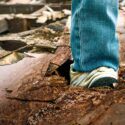You’re about to finish your dinner. Suddenly the table starts shaking. It feels like an earthquake. You get up, and try to get to safety, but it’s too late.
The ground roars, and it sounds like the gates of hell are opening. Before you can make a move, your entire home is underground.
Sinkholes are pits in the ground, formed when water in the atmosphere reacts with carbon dioxide and forms a slightly acidic water. When it goes underground, it circulates through sediment like limestone, dissolving it.
Eventually, this erosion creates big caves full of air or water. When a sinkhole forms it can be a shock, since the land above it can stay intact for quite some time. The danger comes when the underground caves get too big.
When there isn’t enough support for the land above the caves, the land suddenly collapses. Luckily, most sinkholes form slowly, and they don’t get too big. But what happens when they’re massive and unexpected?
Should you try to escape, or wait for help? How deep can sinkholes get? Are you living on top of a sinkhole right now?
The U.S. Geological Survey estimates that 20% of Americans live in areas prone to sinkholes, and Florida has the highest risk. The world’s biggest sinkhole is in Shaanxi Province, China. It measures 520 m (323 mi) in diameter and 320 m (199 mi) deep.
But sinkholes are found worldwide. From Japan, to the Bahamas and Guatemala. Although it’s uncommon for a whole house to be swallowed by a sinkhole, it’s definitely possible, especially if you’re in sinkhole-prone regions.
The thought of your home being devoured by the earth can be unsettling. But here are some tips that will help you live and tell the story.
Step 1: Know where you stand
The best way to survive being swallowed by a sinkhole is to prevent it from happening. Check around your house and yard, and look for these signs that a sinkhole may be forming.
A circular depression, lake, or deep puddle may appear, or unusual cracks in the pavement, roads, or your foundation. If the rainwater disappears into openings in the ground, that’s not good. And watch for doors and windows that become unusually difficult to open.
If you live in an area where sinkholes tend to form, it’s crucial to stay vigilant. If a sinkhole appears, and it’s threatening your home, get out right away. Then contact emergency personnel.
But what if the hole is less than a meter (3.2 ft) in diameter, and it’s not affecting your home’s foundation? Keep monitoring it. If the hole does not get bigger, you can fill it yourself.
Step 2: hang on for the ride
You couldn’t see any signs of a sinkhole forming. But now your house is falling, and you’re inside. It’s too late to run, so get down. Use your arms and hands to cover your head and neck. If you can avoid being hurt as your house falls, it will increase your chance of surviving.
Step 3: Wear A Mask
Your house has stopped moving, and you survived the fall. First, stretch your shirt over your nose and mouth. It will act like a mask, and help prevent dust or dirt from entering your airways. Next, take a deep breath. Controlling your breathing, and keeping your airways clear, are key to making it out alive.
Step 4: Get in position
There’s a high chance you’ll be trapped under debris and some of the ground. If it’s possible, turn to your side and stay in the recovery position. This keeps your airways open, so you won’t choke on any vomit or fluid.
Step 5: Keep your spirits up
While you’re stuck under the rubble, it helps to stay motivated to survive. Remember all the happy moments in your life and everything you’re thankful for. This will give you extra willpower, and help you to come out of this alive.
Step 6: Use Morse Code
This may surprise you, but your goal is not to get out of the sinkhole. Instead, try to survive for as long as possible so emergency help can get to you.
Don’t waste your time yelling. It’s not likely any one can hear you. So save oxygen and your energy. Instead, wait until you hear voices or movement above you. Then, try to move some rubble in rhythmic taps, like knocking a stone against something, so first responders can hear it. Three short taps, followed by three longer taps, followed by three more short taps is Morse code for SOS — save our souls.
Step 7: Don’t climb the hole
If you landed on the top of the rubble, stay where you are, near the middle of the hole. Trying to climb up and out of the hole could cause the loose soil on the sides of the walls to fall down on top of you.
If you have your phone with you, call for help. Hopefully, your neighbours have noticed that your house is missing and called the authorities for you. Hang in there. Help should be on the way. When it comes to sinkholes, it’s better to be prepared and get out beforehand, instead of trying to escape after your house collapses into the earth.
So find out about the ground your house is built on, and stay alert for the signs a sinkhole is opening up. Even though you know how to survive a sinkhole, don’t tempt fate. The hole might get deeper than you expect.
Sources
- “The 7 Most Common Signs Of Sinkholes”. 2018. AGIUSA.
- “Notice These 9 Sinkhole Warning Signs? What To Do”. 2017. Servicemaster 24 Hour.
- “First Aid – Recovery Position”. 2017. nhs.uk.
- “Why Sinkholes Appear And How To Fix Them”. 2013. Popular Mechanics.
- “The White House lawn has a growing sinkhole — here’s what happens when one swallows up an entire house”. 2021. Business Insider.
- “Sinkhole – Wikipedia”. 2021. en.wikipedia.org.



























